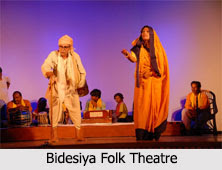Folk dances of Bihar
The 8 popular forms of folk
dances of Bihar
1. Bidesia:
The dances of Bhikhari Thakur, popularly known as Bidesia nach, have for their themes satire on some aspects of the social evils like child marriage, dowry system etc. Elements of drama too were introduced in the dance in as much as the songs have dialogues divided by wits and epigrams. In Bidesia, the female roles are played by the male actor-dancers. Normally, they wear dhoti or shirt trousers and for the appearance in case of female roles, they are artificial long haired for the same. Though many new means of communication and entertainment are developed recently, Bedesia remains the most popular and refreshing relaxation for the Bhojpuris.
2. Jat-Jatin Dance :
Theme of the Jat-Jatin dance of Bihar explains the story of the lovers Jat-Jatin, who were separated and living in difficult situations The Jata-Jatin dance has for its theme songs invoking rains. It is also known as Yakaha Nirtya and mostly is in accompaniment to the songs. The steps are lively and vigorous with delicate bodily movements, four steps forward and an equal number back. It being a dance only for girls, they fall into two groups, one Jata and the other Jatin. The dance starts with an invocation to Yakasha and a prayer for rains. The rhythm is kept to six, seven or eight beats i.e., Dadra, Teevta and Kerwa, Foot patterns are not very intricate but the movements of the limbs are graceful and soothing.
3. Jhijhia dance :
Jijya or Jhijhia is one of the most eminent dances of Bihar, Jhijhia depicts a band of young belles adoring and offering.Rain plays crucial role in agriculture. When there is a total drought and there is not even a single drop of water anywhere, the lands are cracked and parched, the sky is lifeless without clouds and the people are awaiting rains-this is the time when the village women pray to lord Indra for rain. They sing and dance to please the Lord of Rain with their deep devotion. Such type of dance and singing is called jhijhia.This is the message of the most eminent folk dance of Bihar. The performers for this ritualistic dance include a lead singer, harmonium player, bansuri player and a drummer to play the dholak. There are two female singers popular for their rhythmic language, sweet songs appealing music.
4. Jumari Dance :
The folk dance of Jumari is performed especially in Mithilanchal of Bihar. This dance of Bihar is similar to that of ‘ Garba performed in Gujarat.’ Only married women performs, hence it also signifies a good omen. After the month of Ashvin in September- October, the next one is the Kartik month and at this time, the sky becomes crystal clear, without any traces of clouds. The full moon looks attractive and spreads its milky rays in all directions. Such a romantic atmosphere gets the married women to go on dancing, singing and celebrating the funs of the season. Actually, Jumari is related to the season.
5. Kajari Dance :
The pleasant change that has come due to the rainy season. Not only the change in the nature, but also the mental refreshment and relaxation that is associated with human beings is well described in these kinds of songs. Kajari songs produce a sweet sensation body and it is sung from beginning of the shravan month with the rhythmic note of raindrops.
6. Sohar-Khilouna Dance :
Sohar, having its own distinctive diction, is a ceremonial dance to celebrate the pleasure of new birth in a family. It is celebrated all over the country with different traditional rituals. Sohar is sung in Bihar on the occasion of birth of a child. While singing, ladies praise the child with Lord Rama, sometimes with Lord Krishna and with many other gods. This is a very important function, where all women gather and enjoy. The ladies bless the baby while singing and acting the tender words of Sohar ‘Marchia baithal sasu pucheli’. –employed as a single unit, as his language. This body language is extremely poetic and powerful. The legs form an effective means of communicating the expression. Although the face is covered by the mask it mysteriously expresses the feelings to be communicated.
7. Fagua :
Holi is a festival of colours celebrated all over the country. People celebrate it on the first day of the Hindu Calendar, that is Pratham Chairtra Mass’ (February-March). The well known festival Holi conveys the message for religious integration apart from any sort of bigotism. In Bihar, a typical style ‘Dhamar of holi song is sung in which the villagers celebrate it in a form of group with full joy and dance with musical instruments like dholak, Jhal-manjeera, etc. This dance is related to the mythical story of Bhakt Prahlad and his demon father Hiranyakshipu.
8. Domkach :
Traditionally Domkach is played in Mithila region. The word kacchab means in old Maithili to play the role of or to mimic some one. So, domkach means ‘playing other’s role by the men of dominant caste’
The ladies bless the baby while singing abd acting the tender words of Sohar “Marchia Baithal sasu pucheli”










Comments
Post a Comment